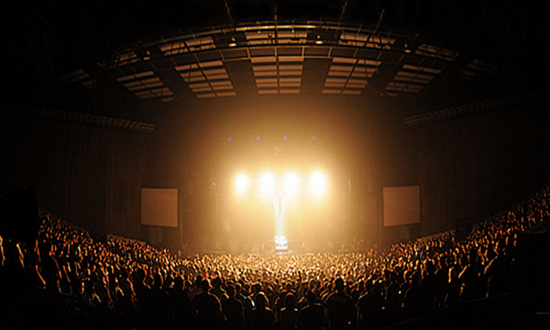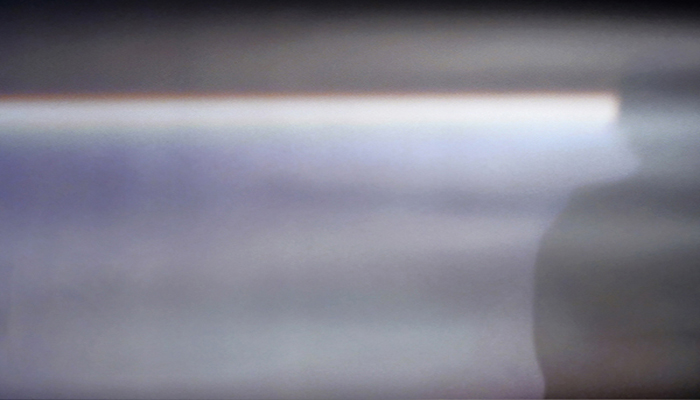
For the last five years I have been developing a methodology I call sensory scenography; creating narrative, performing spaces where the audience are immersed in a specific sensory world. This began with my questions about empathy- whether empathy as an exercise of the imagination can really connect people with the experience of another. Sensory Scenography bases itself on the recognition that it is through the whole sensing body, not only the seeing eyes and the thinking mind, that we perceive and experience our world. Our body situates us in the world. We reach out for sensory information, through the body, seeking to connect.
Fundamental to this methodology is the use of the physiological and perceptual effects of sensory stimulus to create the experience of a situation. Rather than describe or illustrate a situation, sensory scenography uses light, sound, smell, temperature, touch and space to create the sensory conditions of that situation, and stimulate physiological, behavioural and emotional responses to it. Instead of making it look like morning, sensory scenography can also make it feel like morning, or can stimulate the body and mind to react as if it was morning. I make use of the physiological effects of sensory stimulus- how they affect the body- using these to provoke specific states of being in the audience, and create an embodied experience of the work's narrative. Sensory scenography seeks to create inclusive, active, spaces that, without changing the role of the audience, change their perceptual conditions. Rather than imagining yourself in a situation, sensory scenography aims to provoke a response to the sensory conditions of that situation. I hope that in sharing the sensory world of a performance I can create a more porous boundary between the audience and the stage.
Spaces that we inhabit daily are often designed- physically and sensorially- to illicit specific behaviours - and I am interested in how these unacknowledged but accepted practices could be used and critiqued in my work, e.g. sensory marketing in retail stores, or the use of sound in public spaces. I have developed a curiosity about behaviours that can provoke specific muscle memories, and create an uncanny sense of familiarity, even attachment to a space; e.g. repeatedly unlocking doors with a key placed on your own key ring. Continuing, I want to research actions undertaken by groups of people that provoke a sense of responsibility or the need to work together to take care of or activate a space. I am developing an artistic practise that involves audiences in this ongoing research and development of the work. One in which the hybrid nature of the work opens the process up to partnerships from theatre, education, science and technology, and brings together parallel strategies in my work as a maker, light designer and researcher.
SENSING LIGHT
Is an ongoing research into the non-visual and physiological qualities of light and their use in performative spaces. It continues the work that formed the core work of my work during the Masters Scenography at the Frank Mohr and is supported by a starter research grant from the Stimuleringsfonds Creatieve Industrie. This research explores the physiological and perceptual effects of light, sound and smell to create atmospheric spaces that slip underneath rational understanding, to effect the body and mind on a deep level. The work also searched for ways to direct the attention of the audience towards their physiological and perceptual experiences, and create an awareness of their changing states of being. Specific sounds, or words in written texts, actions and tasks were used to engage the body and occupy the questioning mind, creating space for the sensory compositions to work and subtly directing the focus of the audience inwards, to an awareness to the effects on their state of being.
“Her work seems, from my experience, to be about using light, space and time to direct the attention of a participant onto itself in relation to physical and emotional ‘space’ by non-visible transitions over time. Work that confronts ones perception of the self both inward and outward in an surreal experience of the fluidity of both time and space, like moods that come and go having great impact on our perception of reality but at the same time are transitory in nature, ungraspable....
While reading the light in the room changed with such a slow pace that the change itself was hardly noticeable through direct visual verification. Interestingly I noticed the change of ‘light atmosphere’ through a change of, almost physical, mood while being in the room. This experience of a changing space without a verifiable visual perception of the change itself lead to a sense of a surreal subjective perception of both space and time; a dissolvement of a fixed ‘sense of presence and self’ in this transitory space…. I felt the totality of the space, the experience of spending time.....
... Back on the street, I felt like a stranger in my own city. “ Joris Weijdom, on Sensing Light.
My interest in the non-visual qualities of light began with a desire to have the audience experience for themselves the sensory world created for a theatre piece. For me, empathy with another's story is not a mental experience, it is a felt experience. I came to this research as a light designer. I have always thought of my work as focused on creating a relationship between the audience and a performative work or environment. So it came as a profound shock when it dawned on me how little of the audience’s experience of light is included in theatre light design. The 'audience light' is separated from the light of the performance. In fact the light design only begins once the 'audience light' goes out. Light is designed for the performance; for the performers to feel and for the audience to watch. Whilst current theatre discourse speaks of the active role of the audience; that theatre occurs in the moment of reception by the audience, this equal, symbiotic relationship between the audience and the stage is contra-indicated in how we use light in theatre. Even despite the increasing use of non-traditional venues, the audience are generally excluded from the sensory space created for the performance, a world the audience can see but never feel. As Frederick John Kiesler wrote, “space is only space for the person who moves about in it, for the actor and not the spectator.” My ongoing research explores the use of light, space, sound and sensory stimulus to affect an audience’s perception and experience of performative works. I am interested in a re-balancing of the senses in theatre, to address the felt, as well as the seen. And to create a meeting place between the audience and a performative work through shared sensory space.
The research aims to develop what I am calling sensory scenography; immersive spaces that tell their stories through compositions of sensory stimulus designed to provoke specific physiological and emotional states in the viewer. It continues to explore a methodology which poses fundamental questions as to the role of light and spatial design in performative spaces, with specific regard to the relationship created between a designed space and its inhabitants or between an audience and a performative work. I came to the idea of sensory scenography through light, but my research revealed that all sensory stimulus can have perceptual and physiological effects on the body. The work is powerful because it makes use of stimulus that often go unnoticed, despite the huge impact they have on our perception and state of being. But rather than drawing attention to the stimulus or turning it into a light and sound show, sensory scenography seeks to work on the border of conscious perception, and is exploring compositions of sensory stimulus to evoke specific states of being in the audience. The effects are not experienced as a direct response to an outside source, but are experienced as a state of being emerging from within the bodies of the audience.
Sensory scenography seeks to create inclusive, active, spaces that, without changing the role of the audience, change their perceptual conditions. Fundamental to this methodology is the use of space and sensory triggers to create the experience of a thing. Rather than describe or illustrate a situation, I am interested in using light, sound, smell, temperature, touch and space to create the sensory conditions of that situation, and stimulate behavioural and emotional responses to it. Instead of making it look like morning, sensory scenography can also make it feel like morning, or can stimulate the body and mind to react as if it was morning. There is a huge sensory world to explore...
A JOURNEY INTO SENSORY LIGHT
Some short excerpts from my Masters thesis;
"Sensing Light. Using the sensory experience of light to shape the relationship between the audience and the stage."
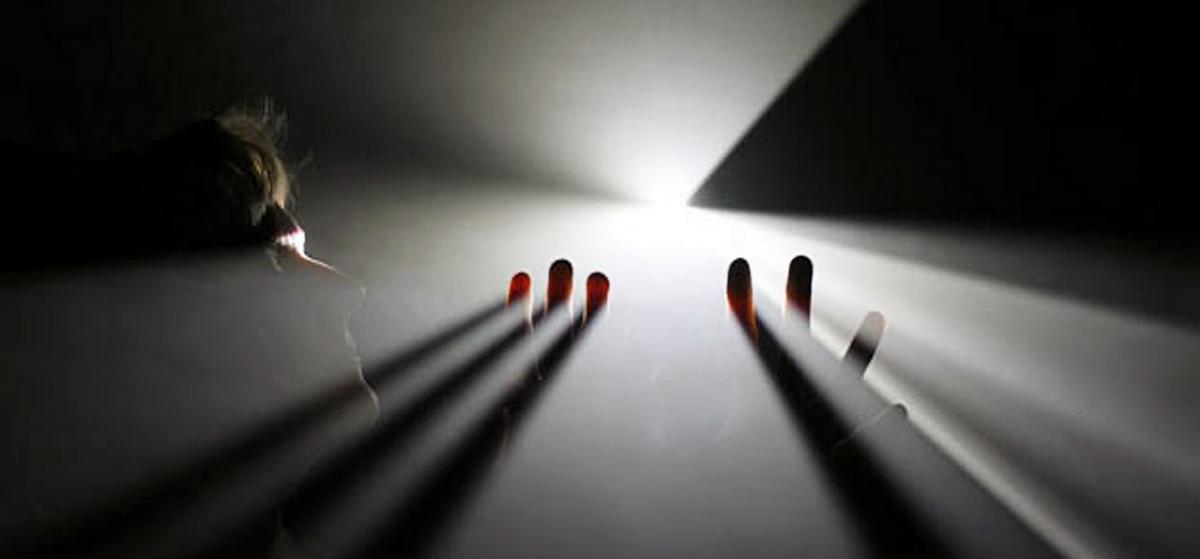
Solid Light Series, Anthony McCall. Serpentine Gallery, London, 2008. Photo David Levene
I have long had a fascination with light. It is a powerful yet untouchable elemental force, able to shape time and space. When I think of light it is the fierce, elemental power of light in nature. The force that turns night into day. For me light has always been a powerful physical experience. After some years of working with light in theatre I began to notice the absence of this physical quality in the light that I was designing and seeing in theatre. I began to wonder, is it just a personal connection I have with the physicality of light, or is this experience of feeling light common to everyone? And how is it that we feel light anyway? Do we experience light with more than just our eyes? And what then are the effects that it has on our bodies and minds? Is it possible to experience this quality in theatre, or does the idea of the fourth wall turn light into a purely visual medium, one that an audience can watch but never feel?
“No man of the theatre who has given any thought to the matter believes that theatre can be reduced to the stage. If theatre is confined to the stage, it dies. A theatrical event is first and foremost an act, in which everyone participates in different ways. The place where this act occurs is one of receptivity, of contact, of living exchange; from it, living expression arises.” Adolphe Appia
At the same time I also started to think about light in terms of the relationship it creates between the audience and the stage. It is through light that we have come to see theatre as a living art that occurs within the transmission and reception of the work between the stage and the audience. But since the development of the modern theatre, it is also a tool by which we keep that audience separated from the world of the stage. Light is designed for the performance, for the performers to feel and the audience to watch. In fact, the light design for a performance only begins once the audience light goes out. And the audience light is always the same, regardless of the performance. I started to think about how this shapes the relationship between the audience and the stage, and how different ways of using light could affect this relationship and an audience’s perception and experience of a work of theatre. This connection I have with physical light started me thinking of light as a part of the sensory world of a performance; to think of light as not only a visual medium, but as a sensory medium. I wondered if it were possible for the audience to also experience light as a sensory medium within the experience of theatre?
THE EXPERIENCE OF LIGHT. THE NON-VISUAL EFFECTS OF LIGHT ON THE BODY AND MIND
"Light is the basic component from which all life originates, develops, heals, and evolves." Arthur Zajonc
The human eye is capable of only seeing a section of the frequencies of light, what we know as the visible spectrum. I started to wonder if along with this invisible light, is there also light that affects the body in unseen physical ways? Light affects us on a level that goes way beyond the visual, or even the psychological or emotional. Light can penetrate our very skin, and affect the basic functions of the human body. Light sustains all life on the planet, and almost all organisms have developed a daily cycle of wake and sleep in response to it. Our bodies resonate physically to light, and it has the ability both to harm and to heal us. We all know the effects that sunlight, or a lack of it, can have on our bodies and minds. Most of us feel better on sunny days and get a case of the winter blues when the days shorten and the skies turn grey. Clearly light effects more than just our eyes.
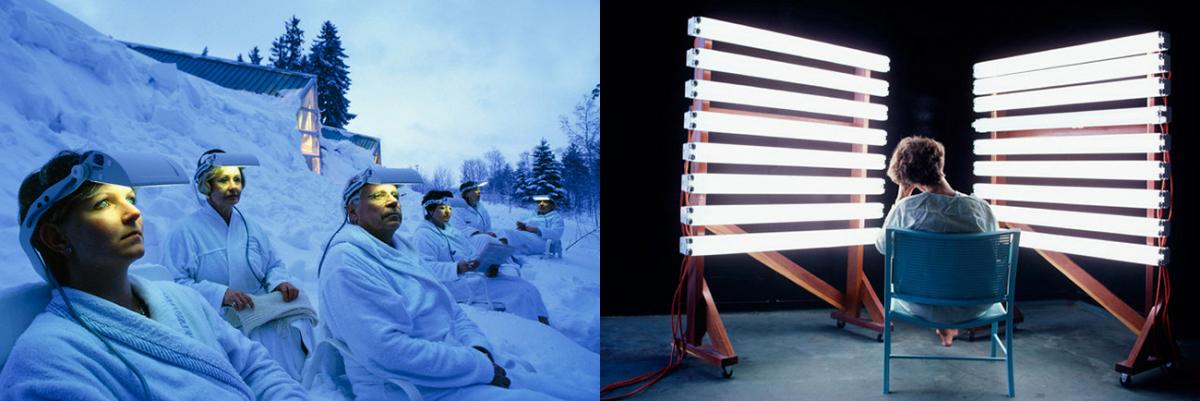
Sleep Research Chronobiology. Photo Peter Ginter. Light therapy for Seasonally Affected Depression. Photo Louie Psihoyos
Science is now confirming many things that have been for a long time intuitively or anecdotally known, discovered through experience, and shared in stories, philosophies, beliefs and rituals. In 2002 a third photoreceptor was discovered in the retina. Called retinal ganglion cells, these photosensitive neurons gather information through the optic nerve and send it to synapses in the brain. This discovery revealed a separate pathway, distinct from the visual system, which mediates the non-visual effects of light on the human body. It showed that light entering the eyes is not solely for the purpose of sight. Further research revealed that the light frequencies that the non-visual systems of the body are most sensitive to are different to those of the visual system. This meant that the non-visual system could be targeted through the use of specific light frequencies. This discovery has led to a surge in research and the development of products and therapies designed to stimulate or inhibit a wide variety of physiological responses of the human body to light.
The non-visual effects of light are having a huge impact on the objectives of architectural lighting design. The demonstrated effects of light on mood, health, healing, communication, productivity and learning outcomes have significantly broadened the criteria of good lighting design. Biological effectiveness will soon be introduced as additional criteria in quality standards for lighting and best practice design now includes the physiological responses of the users, promoting those qualities that are appropriate for an environment’s function and attempting to prevent negative impacts on health and well-being.
THEATRICAL LIGHT THERAPY
There is significant potential in exploring and finding ways to utilize these effects in theatre with dramaturgical intent. For example, I came across a study to see if short exposures to light could influence emotions. Participants listened to both emotional and neutral vocal stimulus while being exposed to different light frequencies. Exposure to some frequencies of light for just forty seconds was seen to have an acute amplifying effect on the participants’ emotional responses. What this research has shown me is that through light we can make connections, with ideas, emotions, environments, and with each, other. Light can create the conditions for an experience of, or connection with, the essence of an object, moment, character or place. As well as making it look like morning, light can also make it feel like morning, or can stimulate your body to react as if it was morning. Or night, or cold, or hot. Or alert, or aroused, happy or sad. The sensory experience of light in theatre does not rely on the physical inclusion of the spectator within a space, but on their sensory inclusion within a continuum of space that can envelop both the audience and the stage.
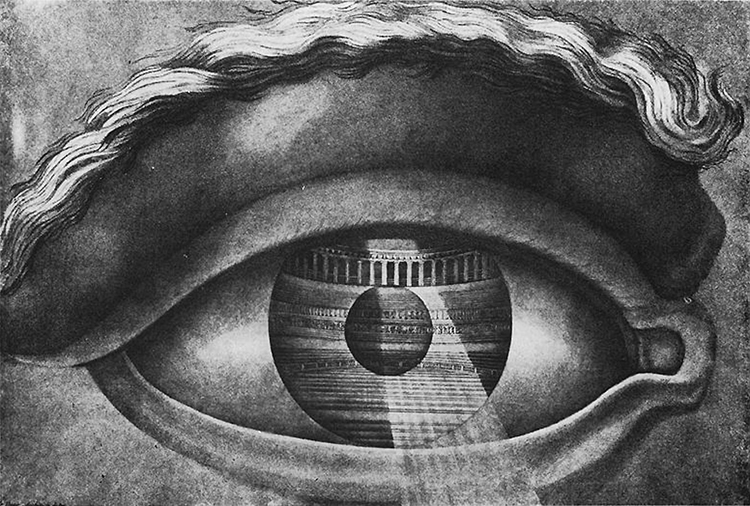
Eye Reflecting the Interior of the Theatre of Besançon (detail), engraving Claude-Nicolas Ledoux
MORE THAN SEEING. LIGHT, PERCEPTION AND THE SENSES
This research has made clear to me that it is through the whole sensing body, not only the seeing eyes and the thinking mind, that we perceive and experience our world. The separation of the brain and body and the dominance of vision, along with the separation of the five separate senses, are cultural constructions that reflect, and in turn shape, our worldview. It is not simply a matter of dividing the experience between the sense organs that gather sensory information and the brain that makes sense it. The separation of the senses only seems possible if we consider perception as something that happens to a brain separated from the body within which it lives. The senses not only receive a wide variety of information about the world we live in, but also process and make sense of that information, before it reaches the brain. Sensations are triggered before thought, which means there is an innate embodied understanding of sensory stimuli that occurs prior to conscious thought. Our sensory systems ‘think’ as much as our rational consciousness does. It turns out that the body’s conscious appreciation of the senses and the level of detail of the information it receives from them is far greater than what it receives from hearing speech.
We reach out for sensory information, through the body, seeking to connect. Our senses are simultaneous and interactive. They seek arousal, they are not waiting inert as passive recipients of information, but actively seeking out stimulus. Perception is not merely passive before sensory stimulation, but as Marcel Merleau-Ponty suggests, is a “creative receptivity”. Philosopher Alva Noë takes the next logical step in thinking of perception as “…not something that happens to us, or in us. It is something that we do.” Similarly, spectatorship is an active, embodied activity, as an audience reaches out to connect with the world of the stage. It is something that we do.
If we take as an example the structure ‘light-illuminated object’ we shall find somewhat vague analogies in the realms of touch. This is why a patient operated upon after being blind for eighteen years tries to touch a ray of sunlight.
Marius von Senden
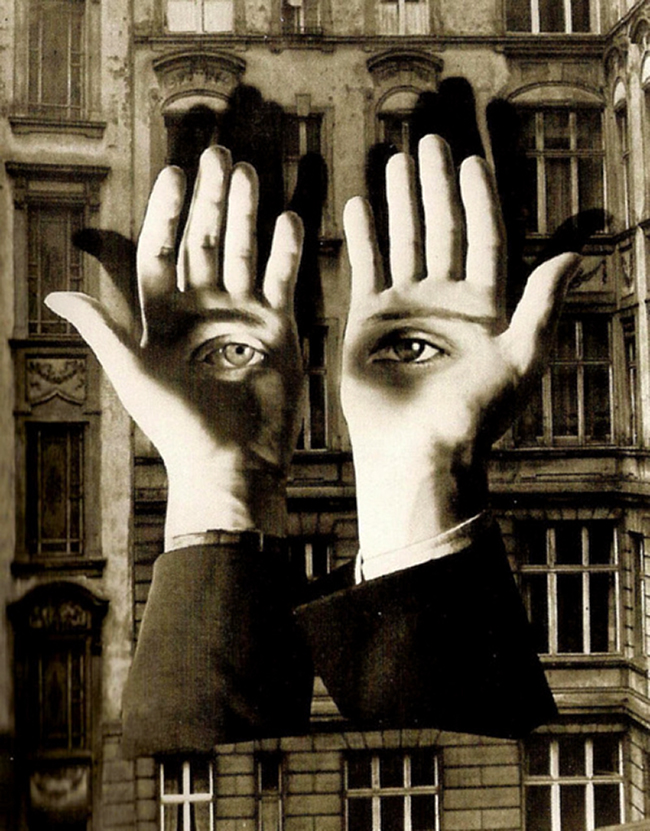
The Lonely Metropolitan, Herbert Bayer, 1932. Victoria and Albert Museum Collections.
Through this research I have come to understand that the basic premise of my work is to use light design to move beyond visual representation to giving a feeling of the essence of something to the audience. This idea can be seen in the words of artist Paul Klee when he says,
Art should not picture the visible, but make the invisible, visible, which means that it must translate the world into new pictorial laws or principals. Instead of the phenomena of a tree, brook or rose, we are more interested in revealing the growth, flow or blossoming which takes place within them.
I have come to a broader understanding of perception and the many layers that we can use in theatre- seen and unseen, conscious or not – to communicate with our audiences. I believe that theatre light is made richer through harnessing all of the qualities of light to use with dramaturgical intent. As a light designer I am naturally concerned with having a thorough understanding of my tools, lamps, electricity, dimmers, systems to create, to shape and control light. But from this research it is clear to me that this is only half the story. The abundant technical knowledge and continued development of the tools to create light in theatre stands in contrast to the superficial understanding of the means of reception of light. An understanding of how an audience perceives and creates meaning is an equally important yet, in my experience, generally unexplored tool of theatre light design. This attests to a school of thought about lighting design that has become increasingly orientated towards what light looks like, rather than how light makes us feel. While is not my intention to ignore or under value the power of the visual in theatre design, I am interested in a re-balancing of the senses, to address the felt, as well as the seen. For I believe in going deeper than the visual, we can go deeper than the spectacle and come closer to the emotional core of the theatre experience. To connect the sensing bodies of the audience with each other and with those on the stage in a movement away from the disconnected and detached Cartesian gaze, to the intimacy of the felt. To touch the audience with light.
The aim of any show is to unite an audience. …This is the very basis of the theatrical experience, its deep meaning: the desire to become one with others, and for a second to hear what it's like to belong to a single human body. … When you share the same world as the person telling the story and the same reality then your imagination can be aroused. You are here and at the same time elsewhere. … One starts out and ends up at the same point: spectator and actor must coexist within a single space that surrounds and unites them.
Peter Brook
